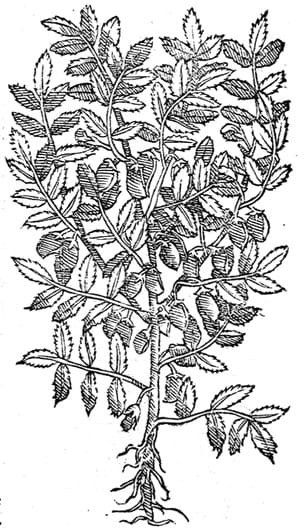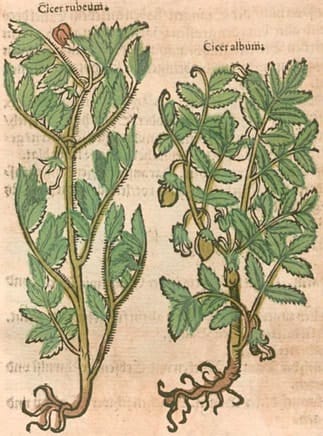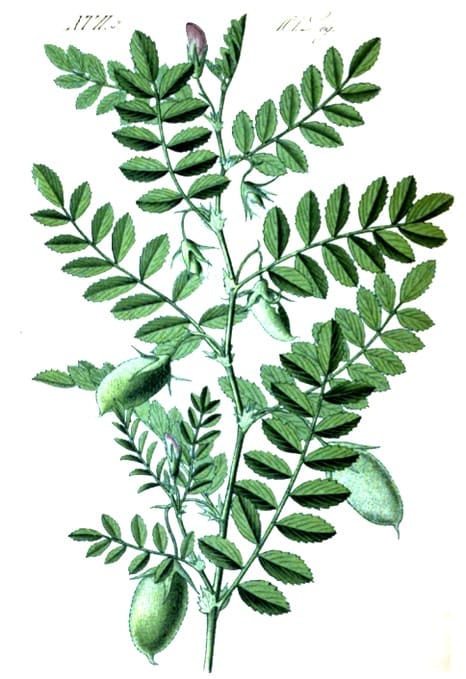Cicer, Chickpea
GarbanzoChana, Himmas (Unani)

|

|
|
Cicer Dioscorides Materia Medica, Mathias, 1563 |
Red and White Cicer Krauterbuch, Lonitzer, 1578 |
 Flora von Deutschland (24), Kohler, 1886
Flora von Deutschland (24), Kohler, 1886Botanical name:
Cicer arietinum
White, Red, Grey and Black Garden varieties were used; Wild and Garden varieties were also differentiated, the Wild being far stronger but the cultivated was accounted more nutritious. (Avicenna)
Parts used:
Seed (grain)
Temperature & Taste:
mildly Warm, dry. Sweet
“White Chickpea is Hot and Dry in the First degree” (Avicenna)
Classifications:
2C INCIDERS. 2F. PURIFYING. 2K. RESOLVENT.
3E. DIURETIC. 3H. LACTAGOGUE. 3I. APHRODISIAC. 3J. INCREASE SEMEN
4g. HEPATIC. 4h. NEPHRITIC
Uses:
1. Strengthens the Kidneys, Benefits Qi:
-increases Sperm; for Impotence and Infertility
-increases strength and vigor
-“These are more nutritive and compact than broad bean” (Avicenna)
-‘increases the Sexual desire very much’. (Avicenna)
-“The infusion of Chickpea causes erection when taken on an empty Stomach”. (Avicenna)
2. Clears Damp, Promotes Urine:
-Dysuria, strangury, Edema, fluid retention, obesity
-decoction is good for the Stone
-‘tartarous mucilage obstructing the Urinary parts’ (Salmon)
3. Moves the Blood, Resolves Stasis:
-promotes Menstruation
–atherosclerosis, cardiopathy, high cholesterol
-used for Tumors and Cancers of the Colon, Penis and Testicles
-‘useful in hot and hard swellings including glandular swellings’. (Avicenna)
-‘improves the complexion both when taken orally or applied’. (Avicenna)
4. Benefits the Lungs, Stops Cough:
-Cough, Bronchitis
-“Clears the Voice”. (Avicenna)
-‘No other substance is considered more nourishing for the Lungs’. (Avicenna)
5. Promotes Milk:
-Nourishes and Increases Milk; prepare a soup from its flour. (Avicenna)
6. Externally:
-the Meal is used externally in Cataplasms
-‘flour is used in Malignant and Cancerous Ulcers’. (Avicenna)
-‘oil of chick pea is useful in Ringworm’. (Avicenna)
-‘Its infusion is useful in molar pain, hot and hard gum swellings and parotitis’. (Avicenna)
-‘beneficial for the moist. pustules on the head’. (Avicenna)
-the meal is mixed with Vinegar and applied to inflammations and tumors (Salmon)
Dose:
Powder: 1–4 grams
In Decoction: 5–15 grams
To nourish the Lungs and increase Breast Milk, Avicenna said a soup made from the flour was best.
It is also taken as food such as Hummus
Preparation:
“Some physicians state that when it is soaked in vinegar and taken on an empty stomach followed by half day fasting, it kills the worms”. (Avicenna)
Main Combinations:
1. For the Heart, make Hummus (Chickpea paste) with Garlic and olive oil.
2. Decoction of Chickpeas: decoct Chickpea with Barley and Marshmallow roots. Good for pains in the sides, colic, dysuria, strangury and gravel.
3. Kidney and Bladder Stones, Chick pea, Almond oil, Radish, Celery as a decoction. (Avicenna)
4. Jaundice and Edema, decoction of Chickpeas with Rosemary (Dioscorides)
5. To Fatten in the thin or undernourished, Chickpea with Rice, Wheat, Barley, Almond, Poppy seed, Sugar (as in Powder to Fatten of Mesue)
6. To nourish and strengthen the Lungs, Chickpea with Almonds, Dates and Raisins.
7. To enrich and promote Milk, with Turnip seed, Aniseed, Fennel seed (as in Powder to Increase Milk Supply)
8. Abscess of the Testicles, Chickpea meal mixed with Honey and applied. (The Secrets of Alexis, 1615)
9. Worms, ‘when it is soaked in vinegar and taken on an empty stomach followed by half day fasting, it kills the worms’. (Avicenna)
Major Formulas:
Syrup of Marshmallow (Fernel)
Powder to Fatten (Mesue)
Powder to Increase Milk Supply
Powder for Kidney Stones from Heat (Unani)
Cautions:
1. Windy and hard to digest if not properly cooked.
2. “Unfavourable for the Ulcers of the Bladder”. (Avicenna)
Main Preparations used:
-
Extra Info
-
History
|
‘This pulse is the Cicer of the Romans. Plautus and Horace speak of ‘Cicer frictum,’ ‘parched- gram,’ which would appear to have been eaten by the poorer classes just as it is in India now. The Italians call it ‘Cece.’ The plant is cultivated in the south of Europe and also in India, the leaves and stems are covered with glandular hairs containing oxalic acid, which exudes from them in hot weather and hangs in drops, ultimately forming crystals. In India the seeds form one of the favourite pulses of the natives, being eaten raw or cooked in a variety of ways; the flour is also much used as a cosmetic and in cookery. Cicer is the [?] of Dioscorides. The acid liquid, which is obtained by collecting the dew from the plant, is mentioned in Sanskrit works under the name of Chanakamla, and is described as a kind of vinegar having acid and astringent properties, which is useful in dyspepsia, indigestion, and costiveness. Moidin Sheriff gives the following description of its collection :— In a great many parts of India, where C. arietinum is cultivated, a piece of thin and clean cloth is tied to the end of a stick, and the plants are brushed with it early in the morning, so as to absorb the dew, which is |
then wrung out into a vessel. The fluid thus collected consists of water holding in solution oxalic, acetic and perhaps malic acid, and according to Dispan, another acid peculiar to the plant. (Watt’s Chem. Diet., Vol. I., p.962.) Dr. Hove (1787) says:— “On the road (to Dholka) we met with numerous women who gathered the dew of the grain, called by the inhabitants chana, by spreading white calico cloths over the plant, which was about 2 feet high, and then drained it out into small hand jars. They told me that in a short period it becomes an acid, which they use instead of vinegar, and that it makes a pleasant beverage in the hot season when mixed with water.” Dr. Hove states that the freshly collected fluid tasted like soft water, but that some which he preserved became after some days strongly acid. According to Dr. Walker (Bomb. Med. Phys. Trans., 1840, p. 67), the fresh plant put into hot water is used by the Portuguese in the Deccan in the treatment of dysmenorrhcea; the patient sits over the steam.’ (Vegetable Materia Medica of Western India, Dymock, 1885) |
